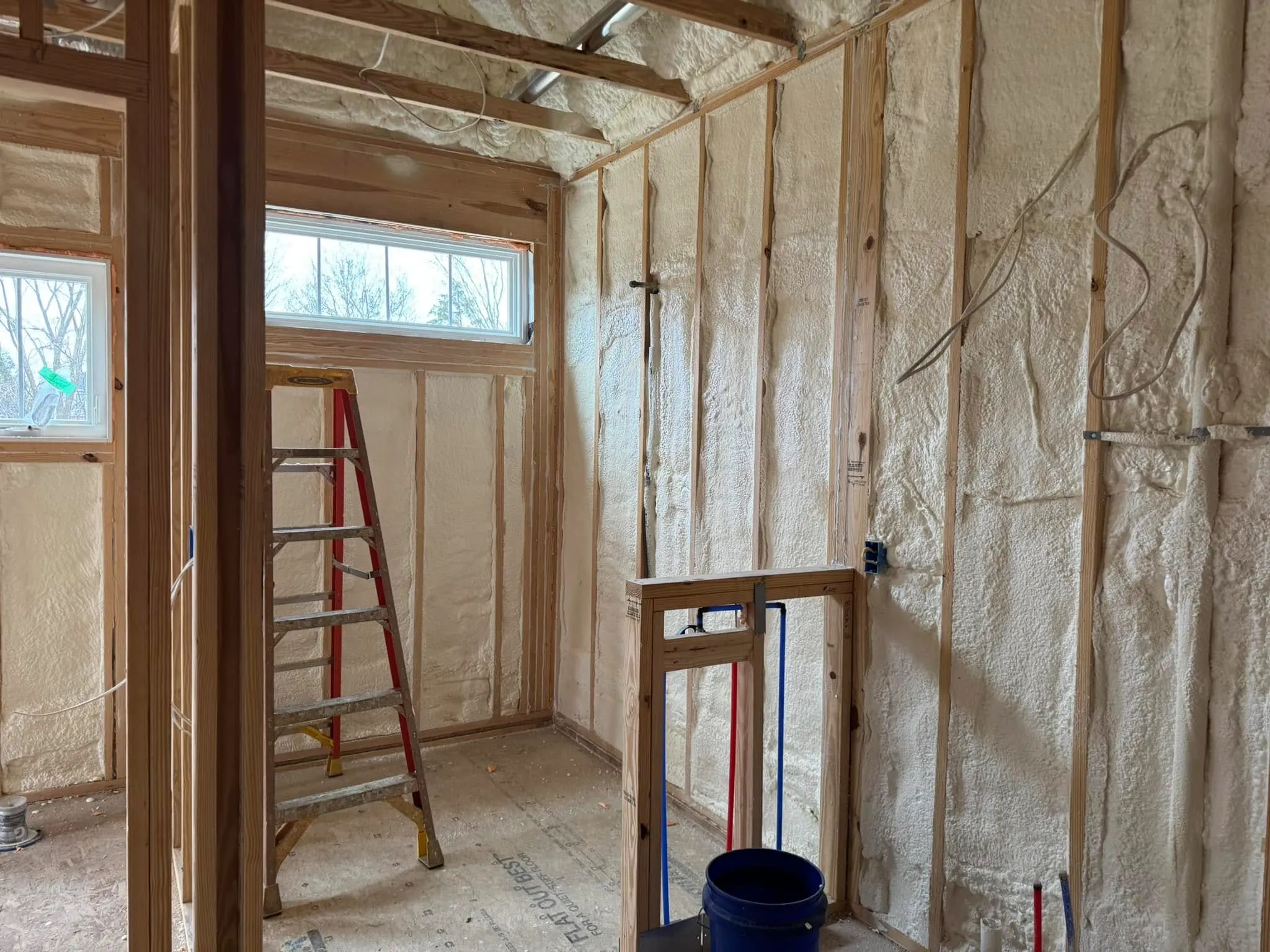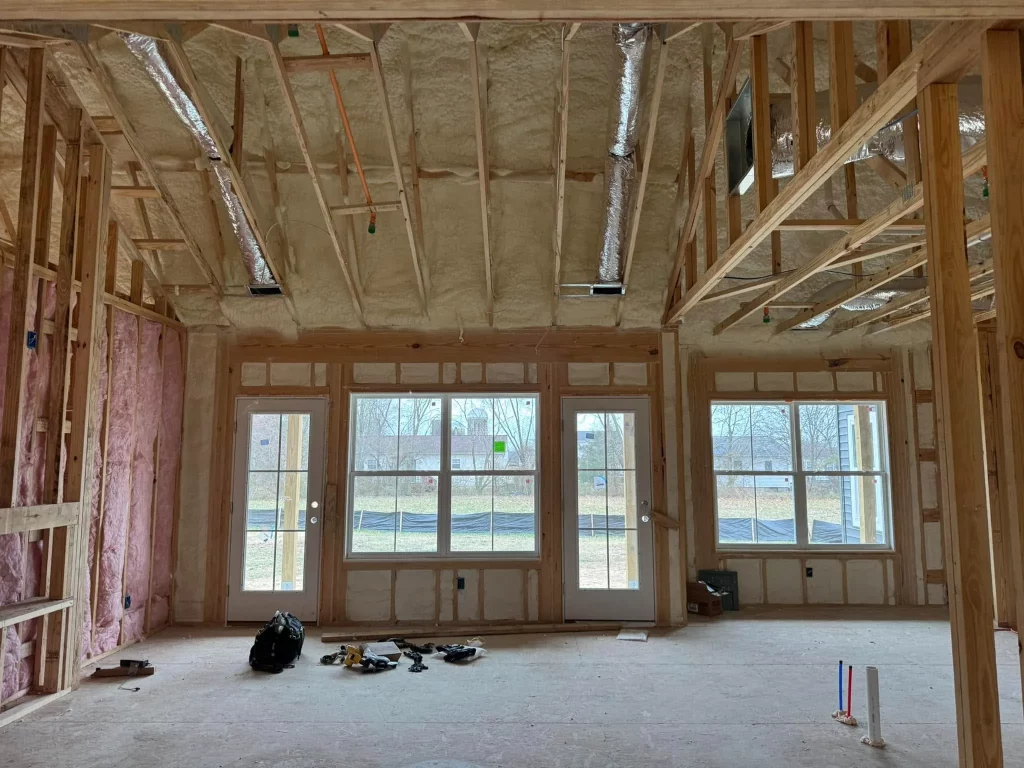
Spray foam insulation expands through a chemical reaction between two main components: polyol resin and isocyanate. When these liquids mix at the spray gun, they react quickly to form a foam that grows up to 100 times its liquid volume. This expansion seals cracks, crevices, and irregular spaces in walls, attics, and crawl spaces of Salisbury homes. The process creates an airtight barrier that blocks air leaks and moisture infiltration, key concerns in the area’s humid coastal climate.
This article explains the step-by-step science behind the expansion, its benefits for local homes, and practical factors to weigh. Based on expertise from Peninsula Insulation, LLC, which draws on extensive hands-on work with Salisbury installations, readers gain a clear understanding of how this insulation outperforms traditional materials in filling gaps completely.
The reaction starts when installers mix the two chemicals under pressure. Isocyanate acts as the hardening agent, while polyol resin provides the flexibility. Heat from the reaction causes the mixture to foam and solidify within seconds. In Salisbury homes, where older structures often have uneven framing, this rapid expansion ensures full coverage without leaving voids.
This expansion behavior varies by foam type, including open-cell and closed-cell varieties. Open-cell foam expands more but remains softer, ideal for soundproofing. Closed-cell foam densifies quickly and offers higher resistance to water, suited for exterior walls in Maryland’s wet weather.
This sequence happens in under a minute, allowing efficient installation even in tight Salisbury attics.
Bonus Tip: Test ambient temperature before application. In cooler Salisbury mornings, warm the components slightly to ensure even expansion and avoid incomplete curing.
Traditional insulation like fiberglass batts leaves air pockets because they don’t conform to shapes. Spray foam, however, flows into every nook before setting. A study by the Oak Ridge National Laboratory demonstrates that spray foam reduces air leakage by up to 80% compared to other methods, based on tests in residential structures.
In Salisbury’s variable climate, with hot summers and damp winters, unsealed gaps lead to energy loss and mold growth. The foam’s expansion creates a continuous barrier, preventing conditioned air from escaping and humid outdoor air from entering.
Market data supports this: The U.S. insulation market grew to $14.5 billion in 2022, driven by demand for energy-efficient homes, according to a report from Grand View Research. In the Mid-Atlantic region, including Maryland, adoption of spray foam rose 15% over the past five years due to building code updates favoring airtight envelopes. This growth underscores the increasing value of spray foam for energy efficiency in regions like Salisbury.
| Insulation Type | Expansion Ability | R-Value per Inch | Moisture Resistance | Best for Salisbury Homes |
|---|---|---|---|---|
| Fiberglass Batts | None | 3.1-4.3 | Low | Basic attic coverage, but gaps common |
| Cellulose Loose-Fill | Minimal settling | 3.2-3.8 | Moderate | Walls, though compresses over time |
| Open-Cell Spray Foam | High (up to 100x) | 3.5-4.0 | Low | Interior spaces needing sound control |
| Closed-Cell Spray Foam | High (up to 100x) | 6.0-7.0 | High | Exterior walls against humidity |
This table shows how spray foam stands out in conforming to irregular spaces, crucial for older Salisbury colonials with settled foundations.
Salisbury’s location near the Chesapeake Bay means high humidity and temperature swings. Spray foam’s expansion seals against moisture migration, reducing condensation risks inside walls. Closed-cell varieties, with their denser structure, provide a vapor barrier that performs well in this environment.
Local building codes, updated in 2021, require better air sealing in new constructions. Retrofitting existing homes with spray foam addresses these standards while cutting utility bills. Energy savings average 20-30% in coastal Maryland homes, per data from the U.S. Department of Energy.
Bonus Tip: In humid conditions, apply closed-cell foam to rim joists in crawl spaces. This prevents ground moisture from rising into living areas, a frequent issue in Salisbury basements.
Assess home age and structure first. Older Salisbury homes may need professional inspection for asbestos or lead paint before insulation work. Budget plays a role: Initial costs for spray foam run higher than batts, but long-term savings offset this through lower energy use.
Ventilation matters too. Proper attic venting prevents trapped moisture, even with expanding foam. Consult local codes to ensure compliance. Additionally, consider the insulation’s environmental footprint: Low-GWP foams reduce ozone depletion contributions.
Energy audits reveal specific gaps. In Salisbury, focus on south-facing walls that gain heat in summer. Prioritize areas with the most air loss for maximum return.
Bonus Tip: Schedule installation during shoulder seasons, like spring or fall in Salisbury. Mild temperatures promote optimal expansion without stressing HVAC systems.

Homeowners often wonder about installation safety. Crews use protective gear to handle chemicals, and the foam cures quickly to minimize exposure.
Another query involves longevity: Properly installed spray foam lasts 25-50 years without degrading.
Durability in pests concerns some. The foam’s closed-cell structure resists termites and rodents better than fiberglass.
For Salisbury’s occasional flooding, elevate equipment during application to avoid water damage.
No, quality spray foam maintains its volume post-cure. Shrinkage occurs only with poor mixing or extreme temperatures, but standard products stabilize within hours.
The initial expansion completes in 10-30 seconds, with full curing in 24 hours. In Salisbury’s moderate climate, this timeline holds steady.
Yes, once cured, it emits no harmful vapors. Certifications from the EPA confirm safety for residential spaces.
It excels at voids up to 4 inches deep. For larger cavities, multiple passes ensure complete fill without waste.
Trained applicators control the mix ratio to match space needs. Over-expansion rarely happens with precise equipment.
The expansion of spray foam relies on a reliable chemical process that seals Salisbury homes effectively against air and moisture. Key points include the rapid reaction for gap-free coverage, superior performance in local climates, and considerations like home assessment and codes. Evaluate your property’s needs, climate challenges, and energy goals to determine if this insulation fits.
For details on spray foam applications in Salisbury, contact Peninsula Insulation, LLC at (410) 770-2624 or email wil@mdsprayfoam.net. Discussions help clarify options based on specific home setups. This step provides tailored insights without commitment.